Penang, Malaysia - History, Culture and Cuisine
Famed throughout Asia for its mix of cultures, Penang is Malaysia's Primary Culinary Hotspot.
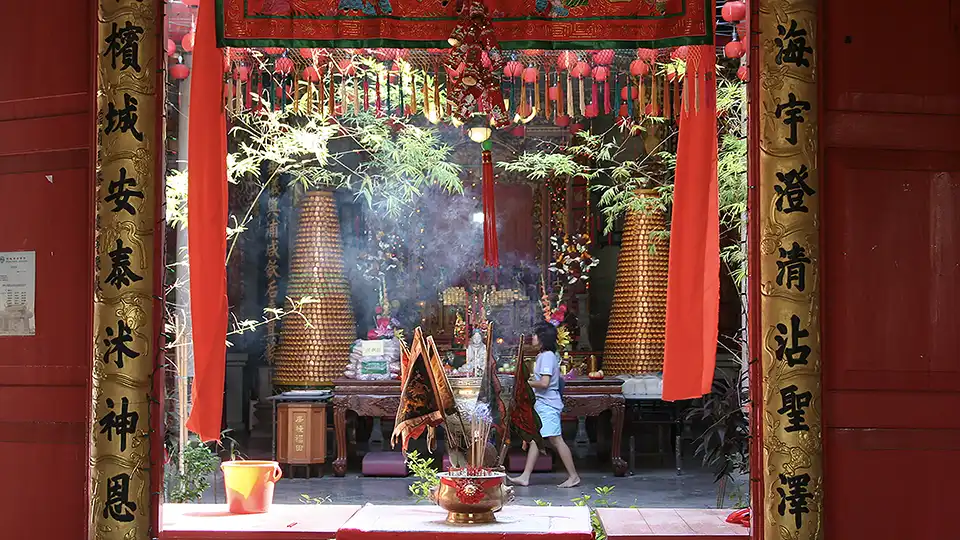
Clan House, Penang, Malaysia
Introducing Penang
Discover the enchanting beauty of Penang, a state situated on the northwest coast of Peninsular Malaysia. Renowned for its rich cultural heritage and vibrant history, Penang captivates visitors with a unique blend of Malay, Chinese, Indian, and European influences.
Explore the UNESCO World Heritage Site, George Town, where colonial architecture meets contemporary street art. Indulge your taste buds in the diverse and delectable street food scene, offering iconic dishes like Penang laksa, char kway teow, and nasi kandar.
Immerse yourself in the cultural tapestry as you visit temples like Kek Lok Si and experience the festivities of Chinese New Year, Thaipusam, and Hari Raya Aidilfitri. From the panoramic views of Penang Hill to the natural wonders of Penang National Park, the state offers a perfect blend of urban excitement and natural beauty.
Whether you're strolling through the historic streets, enjoying the local cuisine, or marveling at the diverse architecture, Penang promises an unforgettable experience for every traveler.
Some History
Prehistory of Penang
The prehistory of Penang, like many regions, is characterized by the absence of written records, and our understanding relies on archaeological findings. Penang has evidence of human habitation dating back thousands of years, indicating a long and complex prehistory.
Archaeological excavations on Penang Island have unearthed stone tools and artifacts, suggesting that the region was inhabited during the Stone Age. These artifacts, such as stone adzes and flake tools, provide insights into the tools and technologies used by early inhabitants.
While not directly on Penang Island, the nearby Bujang Valley on the mainland of Peninsular Malaysia has archaeological sites dating back to the 1st to 5th centuries CE. Bujang Valley was a significant trading and cultural center during this time, with links to various Asian civilizations, including Indian and Chinese.
Penang's strategic location in the maritime trade routes of the Indian Ocean and South China Sea suggests that it was likely part of early trade networks. The presence of imported goods and artifacts from distant regions indicates the engagement of local communities in long-distance trade.
Archaeological investigations on Penang Island have identified prehistoric sites, such as caves and rock shelters, where evidence of early human activities has been discovered. These sites offer glimpses into the lifestyles, tools, and possibly the cultural practices of the prehistoric inhabitants.
Due to the lack of written records, much of Penang's prehistory is pieced together through archaeological studies, making it challenging to provide a detailed chronological account of early human activities in the region. Ongoing archaeological research continues to contribute to our understanding of Penang's prehistory.
the Malay people were present in the region that is now Penang long before the arrival of Captain Francis Light and the establishment of the British settlement in 1786. The area was originally inhabited by indigenous communities, including the Orang Asli, who are considered the native people of Peninsular Malaysia. The specific ethnic group known as Malays, who share cultural and linguistic ties, have a long history in the broader Malay Peninsula.
The Sultanate of Kedah, which included the region of what is now Penang, had historical ties with the Malay culture and civilization. The Sultanate of Kedah exercised authority over the area, and Malay influences were prevalent in the region.
When Captain Francis Light arrived, he negotiated with the Sultan of Kedah to obtain Penang for the British East India Company. The establishment of the British settlement did not displace the existing Malay population but rather marked the beginning of a period of colonial influence in the region. Over time, Penang became a melting pot of cultures, with the coexistence of Malays, Chinese, Indians, and various ethnic groups contributing to its diverse heritage.
About The Area
The People
The cultural diversity of Penang is its greatest strength. From the various Indian and Chinese groups that settled here, the British Colonial legacy, the proximity to Southern Thailand and the Malay hinterland - all contribute to the milleau that makes up Penang. This contributes not only to a vibrant food scene and a calendar of festivals, but also to ways of doing things that has evolved to accomodate and enhance the lifestyles of all Penang society
Chinese Ethnic Groups
Hokkien: The largest ethnic group in Penang, the Hokkien people hail from southern Fujian Province in China. They arrived in significant numbers in the 18th and 19th centuries, drawn to opportunities in trade and commerce. The Hokkien language and dialect are widely spoken in Penang.
Teochew: Another prominent group, the Teochew people originated in eastern Guangdong Province. They established themselves during the 19th century, often working in the agricultural and fishing sectors
Cantonese: Migrating primarily from Guangdong Province, the Cantonese people arrived in Penang throughout the 19th and 20th centuries. They have, and continue to play a significant role in Penang's commercial sector
Hakka: While less numerous to other Chinese groups, the Hakka people also contributed to Penang's development. They came from the mountainous areas in southern China and were known for their hard work and agricultural skills
Peranakan
The Peranakan are a fascinating group who are descendents of Chinese immigrants who intermarried with local Malay many centuries ago. They have their own distinct culture with their own distinct food and customs.
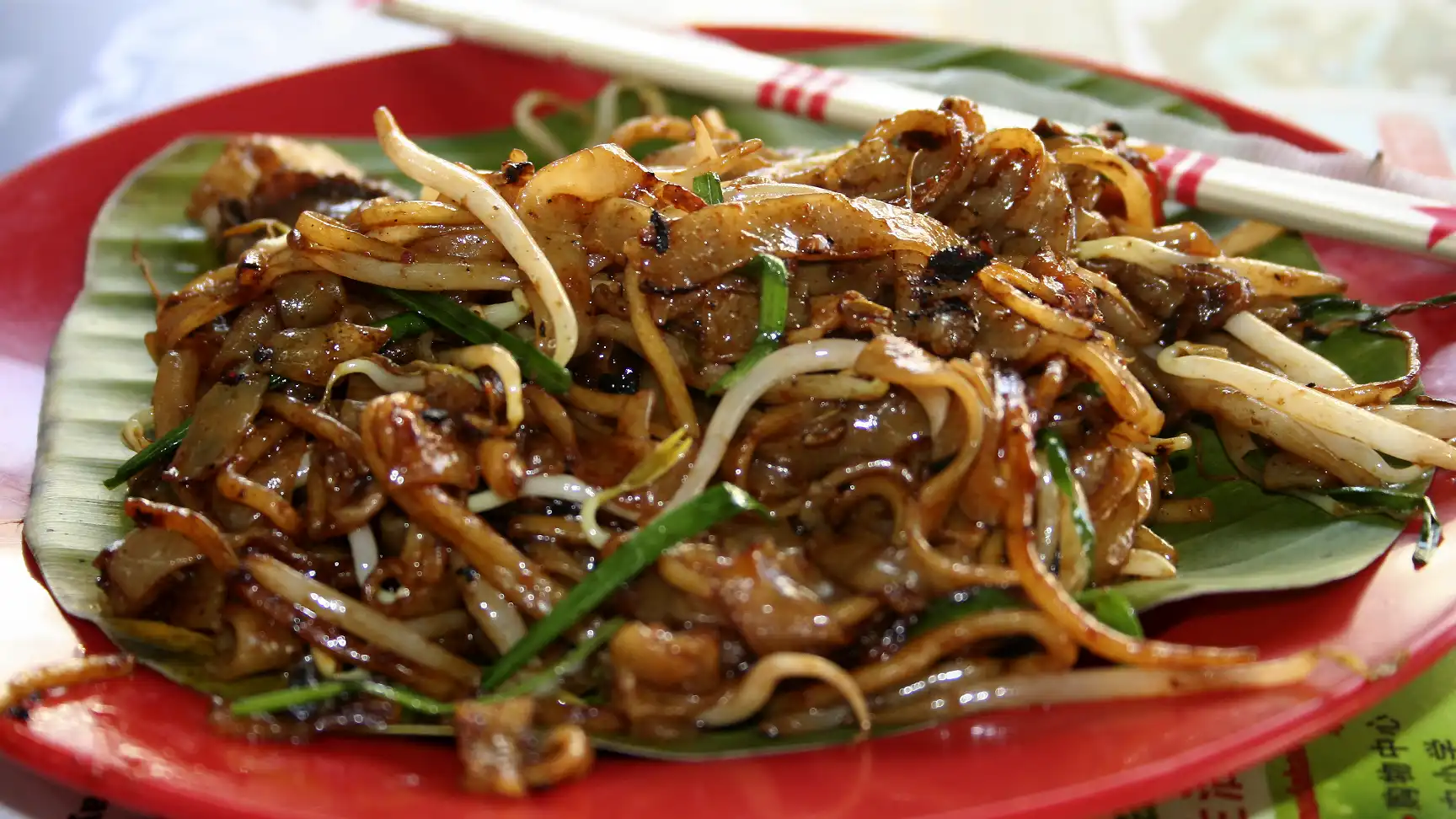
Char Kway Teoh (spelling may vary) is a specialty of Penang
Indian Ethnic Groups
The Indian groups in Penang are primarily of Tamil origin, although there are also sizeable groups from Andra Pradesh and Kerala. Recent additions to the Indian cultural mix include Bangladeshi and Indian Muslims from other states.
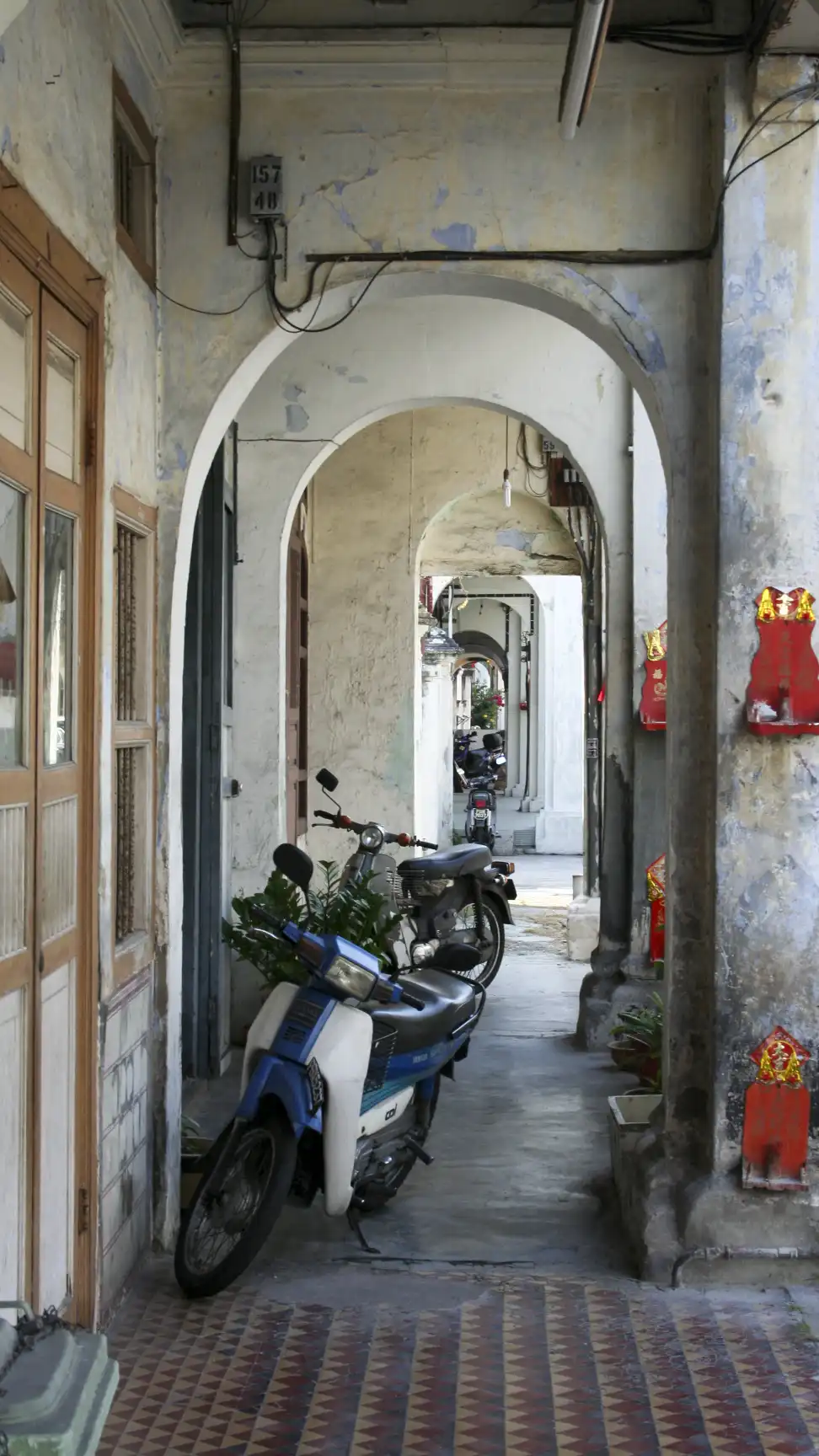
Old Colonial Street in Georgetown, Penang
The Cuisine
Chinese Food
One of my pet peeves when talking about food is the over-simplification of an ethnic food into a single country. How can you possibly sum up all Chinese food with a single label like this, but hopefully we can expand this section over time to show the true diversity of Chinese food in Penang.
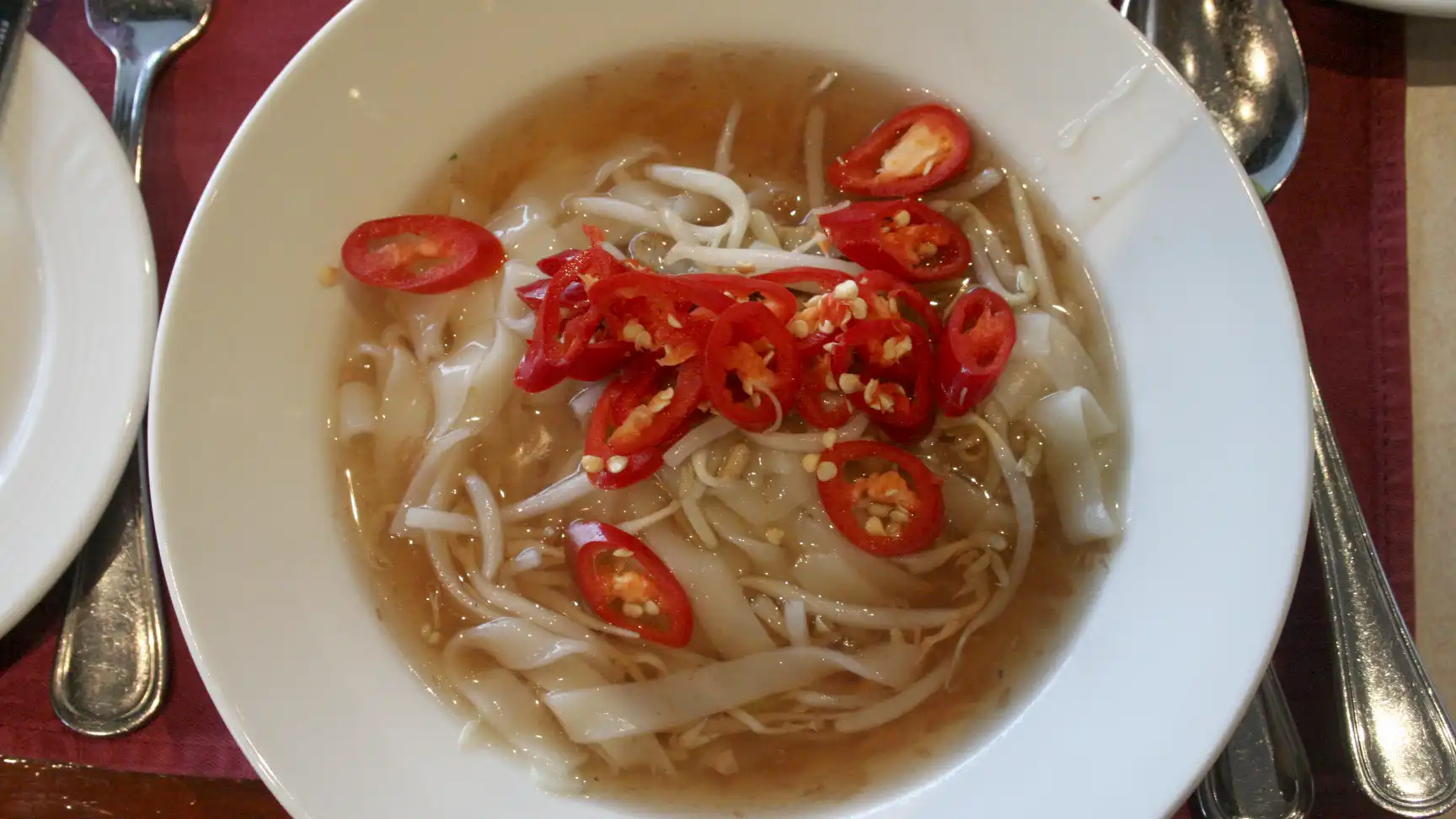
Rice Noodle Soup With Chillies
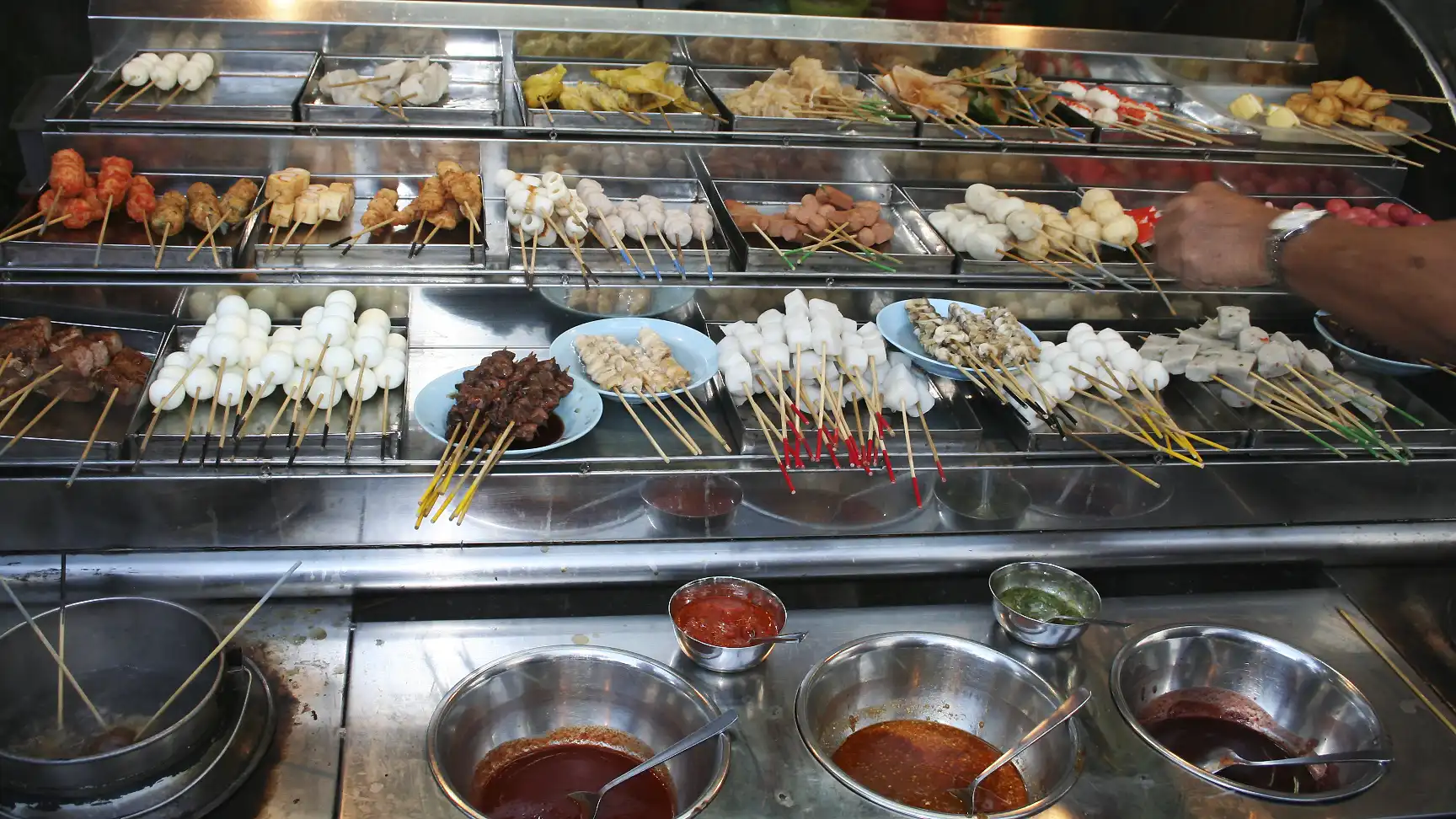
Penang Hawkers Stall
Indian Food
Penang's multicultural background extends to its cuisine, offering a delightful mix of Malay, Chinese, and Indian flavors. When it comes to Indian food, you'll find a delicious array of dishes, some with local twists. Here are some famous Indian dishes you can try in Penang:
- Butter Chicken: Creamy tomato sauce with tender chicken and fragrant spices, often served with naan or roti canai.
- Naan: Leavened flatbread cooked in a tandoor oven, perfect for scooping curries.
- Roti Canai: Flaky flatbread made from wheat flour and ghee, enjoyed plain or with fillings.
- Biryani: Fragrant rice dish cooked with meat, vegetables, and spices (various styles like chicken or mutton).
- Chicken Curry: There must be a 100 different ways to make Chicken Curry, and half the fun is exploring them
- Tandoori Chicken: Chicken marinated in yogurt and spices, cooked in a tandoor oven for juicy tenderness.
- Banana Leaf Thali: South Indian specialty featuring rice, curries, vegetables, and papadums served on a large banana leaf.
- Dosa: Thin, crispy crepe made from fermented rice and lentil batter, enjoyed plain or stuffed.
There are at least 2 distinct Indian cuisines in Penang - Muslim Indian and Tamil Indian, and both are delicious. If you get the chance, try a Nasi Kandar restaurant.
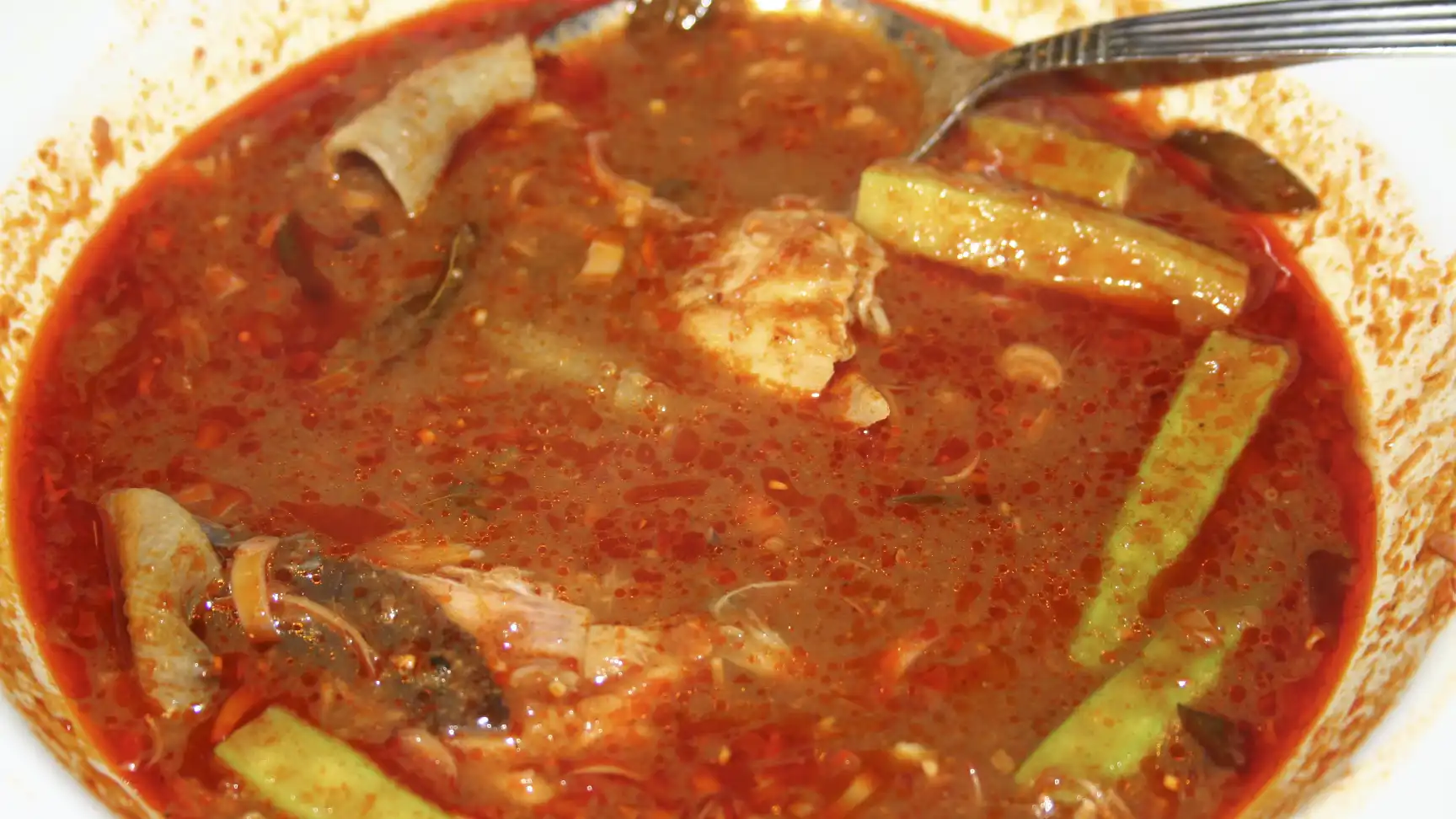
Spicy Indian Chicken Curry
Malay Food
Malay cuisine is a vibrant blend of flavors influenced by Malay, Chinese, Indian, and indigenous tribal traditions. Think aromatic curries rich with coconut milk, turmeric, and lemongrass. Spicy stir-fries featuring chilies, ginger, and shrimp paste are common. Sample fragrant satays, skewered meats grilled to perfection and served with peanut sauce. Rice is the heart of most meals, accompanied by dishes like rendang (slow-cooked braised meat) or sambal (spicy chili paste). Fresh ingredients and bold flavors are central to this delicious and diverse cuisine.
Malay food in Penang is heavily influenced by the fresh seafood available, and includes delicious spicy fish, prawn and shellfish dishes redolent with spices such as turmeric, galangal, chillies and other tropical spices.
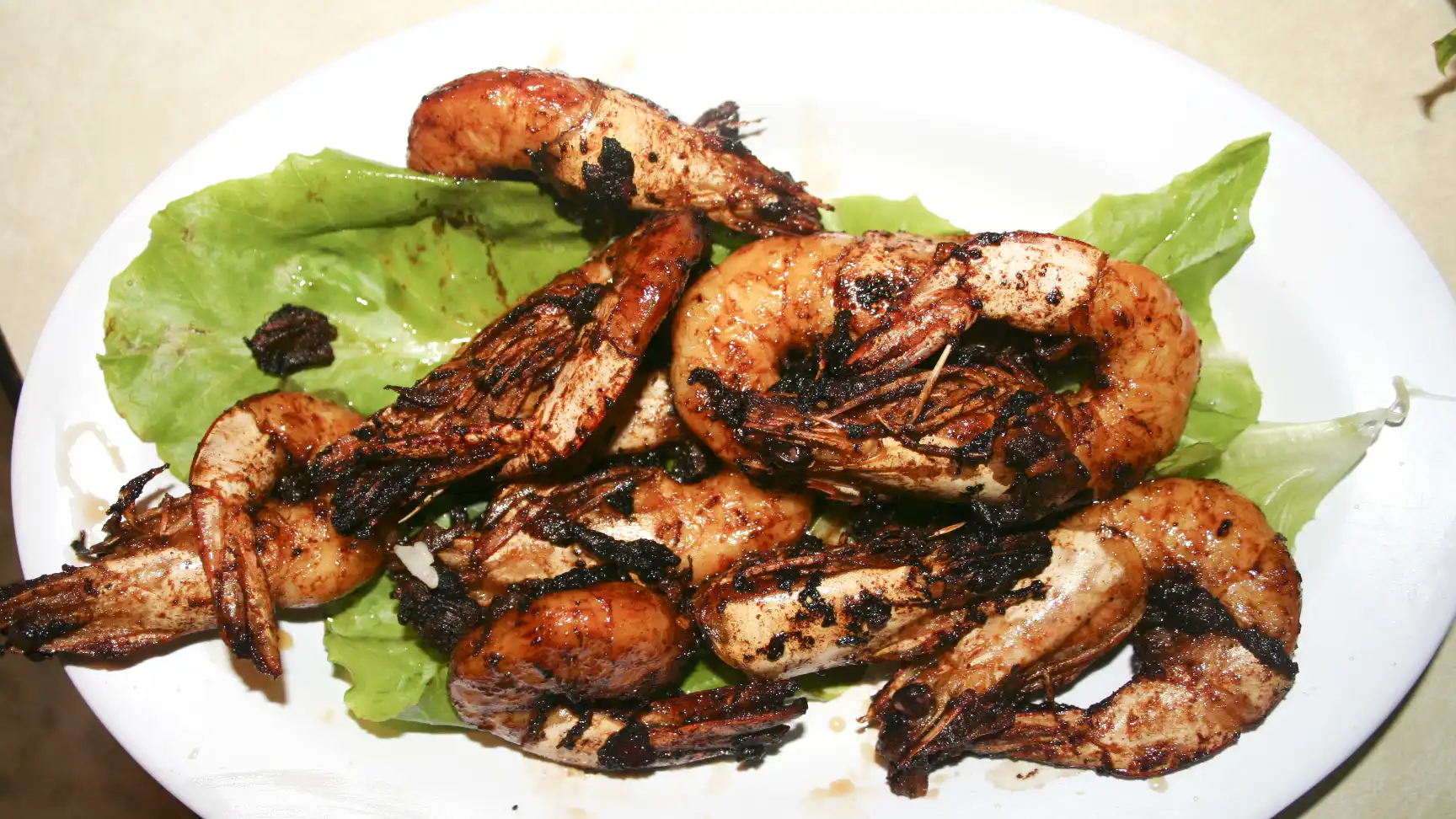
Spicy Grilled Prawns
Nonya Food
Penang Nyonya cuisine is a vibrant tapestry woven from centuries of cultural exchange. It reflects the heritage of the Peranakans, descendants of Chinese immigrants who married into local Malay communities. This unique blend shines through in the use of both Chinese cooking techniques and Southeast Asian ingredients. Expect dishes flavored with ginger, galangal, and candlenuts alongside shrimp paste, chilies, and fragrant spices like turmeric and tamarind. The result is an explosion of sweet, sour, spicy, and savory notes that tantalize the palate.
Penang Nyonya cuisine offers a delightful array of options. Sample rich curries like asam laksa, a fragrant fish broth with rice noodles and a delightful tang. Savor otak-otak, a flavorful mixture of fish, herbs, and coconut milk steamed in banana leaves. Don't miss the tempting kueh desserts, bite-sized treats made from ingredients like sweet potato and glutinous rice, all bursting with vibrant colors and textures. Every dish in Penang Nyonya cuisine promises a delightful adventure for your taste buds.
Fresh Fruits
Fresh fruit is everywhere in Penang. It is, after all, the tropics and the variety and freshness of the fruit is amazing. Served whole, cut into pieces and possibly with Rojak sauce, they are all delicious.
- Durian: The king of fruits, known for its strong odor and creamy flesh. Available from June to August.
- Banana: A staple food, available year-round with many varieties.
- Mangosteen: Beautiful fruit with a deep purple exterior and sweet-tangy flesh. In season from May to September.
- Rambutan: Bright red, hairy exterior with translucent flesh. Available year-round.
- Cempedak: Durian relative with a spiky exterior and milder flavor. Season is from July to September.
- Langsat: Small, round fruit with a golden-brown rind and sweet flesh. Available from November to February.
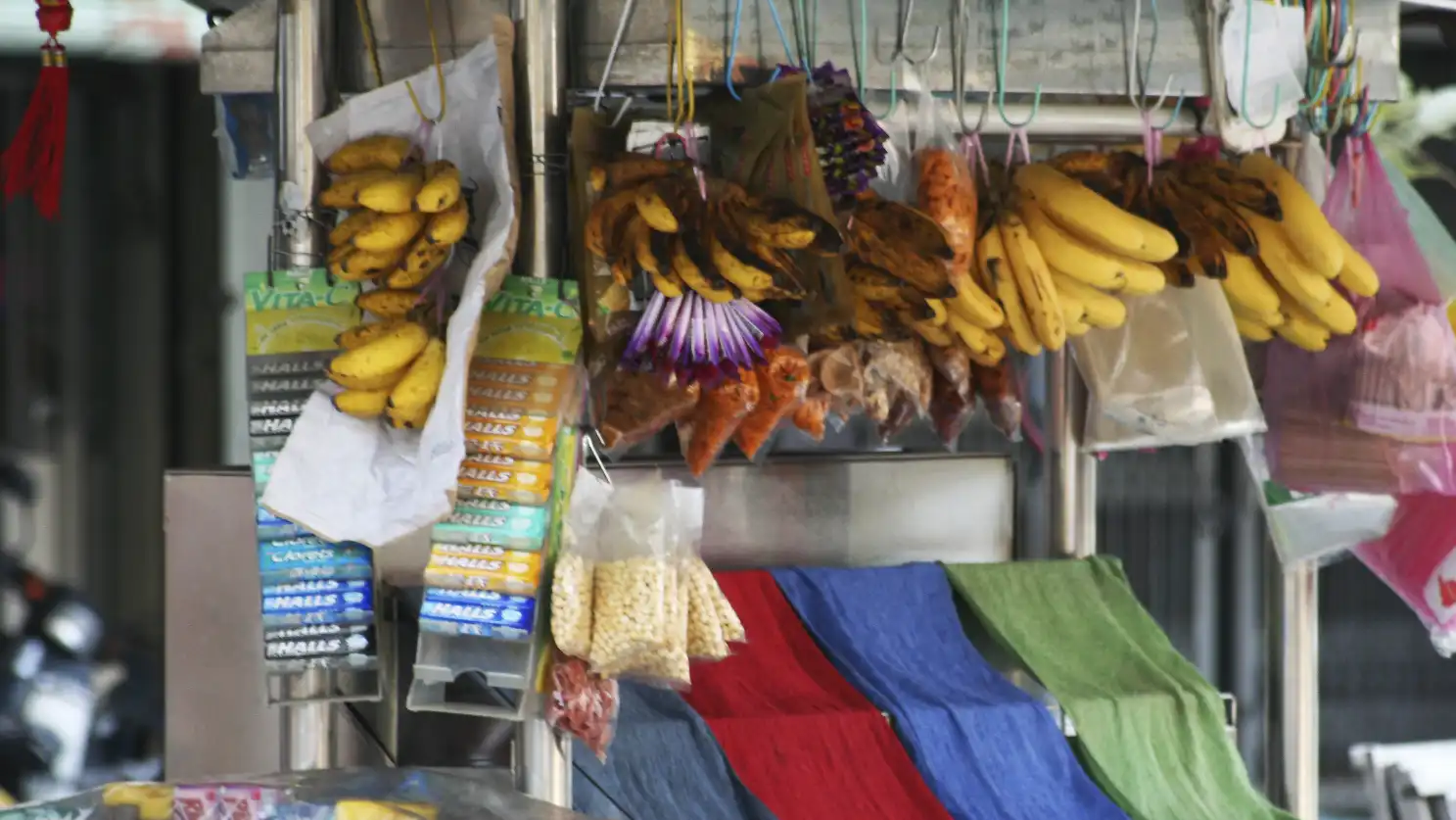
Fresh Bananas at a Roadside Stall
Things To Do
Sights
- Kek Lok Si Temple: This impressive Buddhist temple complex is one of the largest in Southeast Asia. Located in Air Itam, it features stunning architecture, intricate artwork, and panoramic views of Penang Island.
- George Town UNESCO World Heritage Site: The capital city of Penang, George Town, is a UNESCO World Heritage Site. It's known for its colonial architecture, vibrant street art scene, and delicious hawker food, a must-try for any visitor.
- Penang Hill: Penang Hill is a hill station located on Penang Island. Take a funicular railway up to the top to enjoy stunning views of the island and the mainland. Several hiking trails, restaurants, and cafes are also available at the top for a relaxing escape.
- Batu Ferringhi Beach: Batu Ferringhi is a popular beach resort town located on the northwest coast of Penang Island. It's known for its beautiful beaches, offering opportunities for water sports activities. Enjoy the vibrant nightlife scene after a day of soaking up the sun.
- Clan Jetties: The Clan Jetties are a collection of wooden jetties built by Chinese immigrants in the 19th century. Today, they are a popular tourist attraction and a great place to learn about Penang's history and culture. Explore the jetties and experience the unique way of life of the local communities.
- Penang National Park: Penang National Park is a protected area that covers the northwestern tip of Penang Island. It's home to a variety of rainforests, beaches, and wildlife. Go hiking, camping, or swimming in the park and immerse yourself in the natural beauty of Penang.
- The Habitat Penang Hill: The Habitat Penang Hill is a nature reserve located on Penang Hill. It's home to a diverse range of flora and fauna, including gibbons, langurs, and squirrels. Take a guided walk through the reserve to learn about the local ecosystem and spot some amazing wildlife.
- Penang Street Art: Explore the vibrant Penang Street Art scene. Murals and installations are scattered throughout George Town, making it a great place to take a walking tour or explore on your own. Capture creative and colorful photo memories on your visit.
- Penang Peranakan Mansion: The Penang Peranakan Mansion is a restored mansion that was once the home of a wealthy Peranakan family. Peranakans are Chinese people who have assimilated Malay culture. The mansion is a great place to learn about Peranakan culture and see traditional Peranakan furniture, clothing, and jewelry, offering a glimpse into their rich heritage.
- Tropical Spice Garden: Learn about different spices, herbs, and fruits on a guided tour of the Tropical Spice Garden, located in Balik Pulau. Discover a variety of exotic plants and their uses, making it a fascinating and educational experience.
- Penang War Museum: Explore the story of World War II in Penang at the Penang War Museum. Located in Fort Cornwallis, the oldest British fort in Malaysia, the museum offers a glimpse into the historical events that shaped Penang.
- Escape Theme Park: Enjoy a fun-filled day with family or friends at Escape Theme Park, located in Teluk Bahang. This theme park offers a variety of rides, attractions, and shows, providing entertainment for all ages.
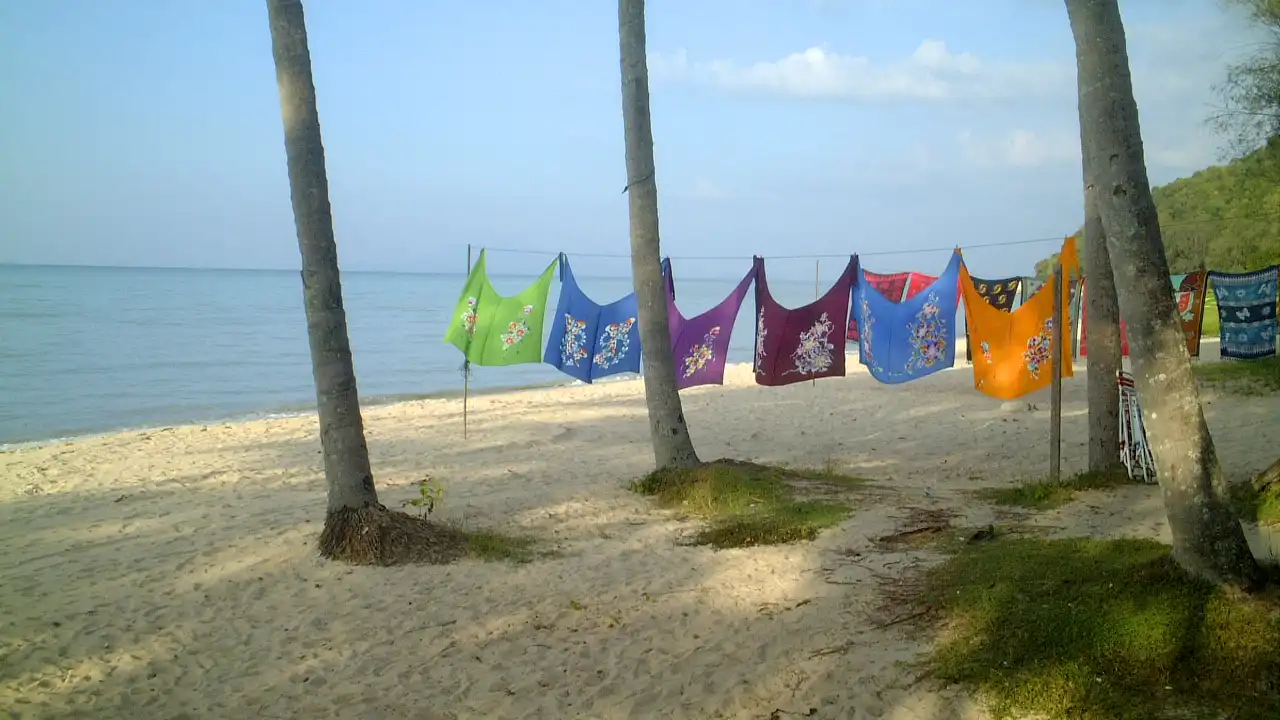
Sarongs Hanging to Dry at the Beach
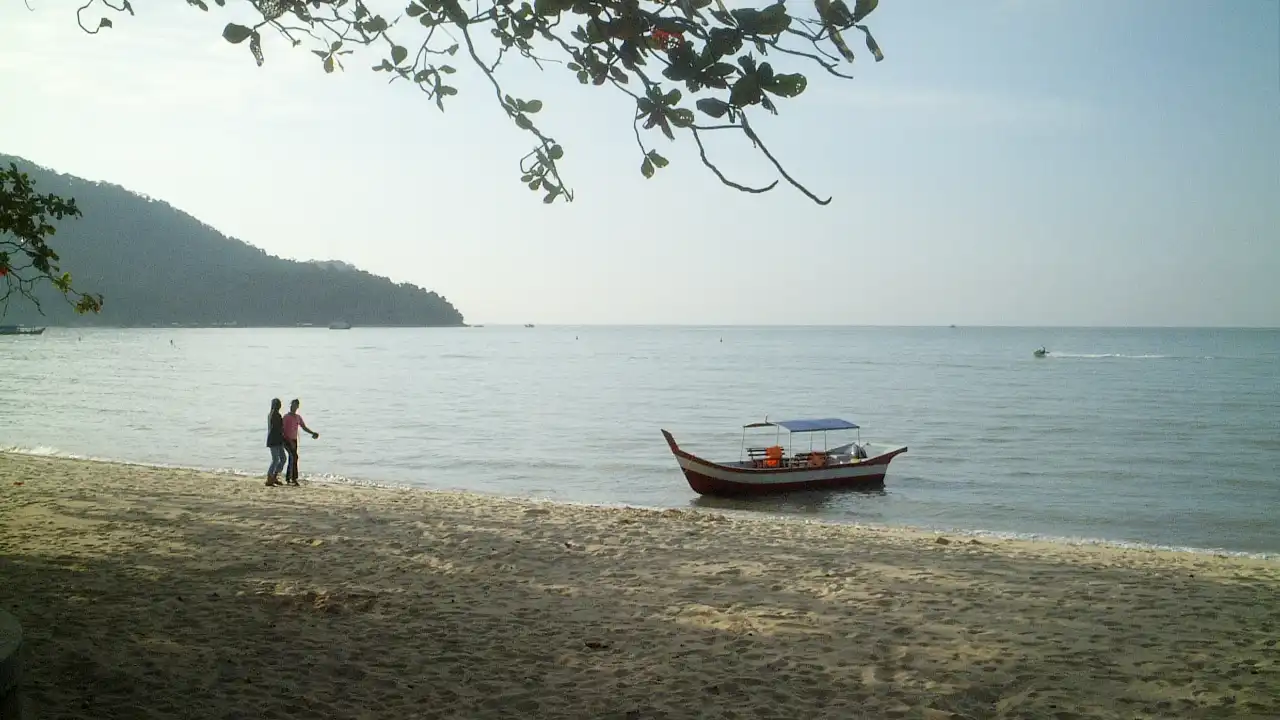
Penang Beach at Dusk
Places to Stay
As a rough guide, luxury hotels can cost over US$500 per night, mid–range hotels perhaps around US$80—120 per night, budget hotels around $40 per night, and as low as US$5 per night for a backpacker hostel, but typically around US$20-30 per night. Most of these accomodations can be booked through our partner website at Booking.com
Luxury Hotels
- Eastern & Oriental Hotel: A historic luxury hotel located in George Town, offering colonial-style elegance and impeccable service.
- Shangri-La's Rasa Sayang Resort & Spa: A luxurious beachfront resort with lush gardens, exquisite dining options, and a rejuvenating spa.
- Four Seasons Hotel Penang: A prestigious hotel offering luxurious accommodations, world-class dining, and breathtaking views of the sea.
- Hotel Equatorial Penang: A five-star hotel known for its modern amenities, excellent service, and convenient location.
- The Ritz-Carlton, Penang: An opulent hotel renowned for its elegant design, exceptional dining experiences, and personalized service.
- G Hotel Kelawai: A contemporary hotel featuring stylish rooms, rooftop infinity pool, and innovative dining options in a vibrant setting.
- Hard Rock Hotel Penang: A unique luxury hotel offering a rock-and-roll experience with lavish accommodations, live entertainment, and themed events.
- Lexis Suites Penang: A luxurious all-suite hotel with private pools, spacious accommodations, and stunning sea views.
- The Prestige Hotel Penang: A boutique hotel blending colonial charm with modern sophistication, offering personalized service and elegant accommodations.
- The Edison George Town: A boutique hotel housed in a beautifully restored colonial mansion, offering a blend of heritage charm and contemporary luxury.
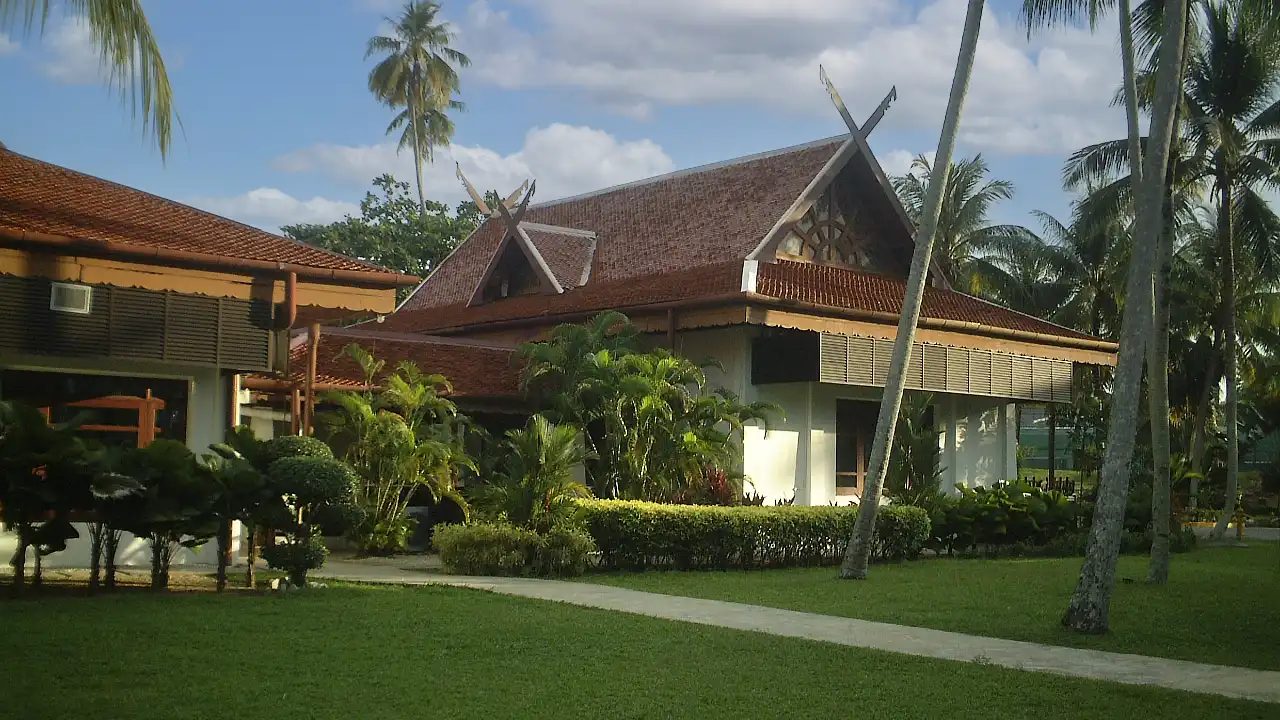
Beach Hotel on Penang Island
Mid–Range Hotels
- Bayview Hotel Georgetown Penang: A centrally located hotel offering comfortable rooms, modern amenities, and convenient access to attractions.
- Sunway Hotel Georgetown Penang: A contemporary hotel known for its warm hospitality, well-appointed rooms, and proximity to shopping and dining areas.
- Nova Highlands Resort and Residence: A family-friendly resort nestled in the hills of Bukit Jambul, offering spacious accommodations and recreational facilities.
- Flamingo Hotel by the Beach Penang: A beachfront hotel featuring cozy rooms, a large swimming pool, and a range of dining options.
- The Gurney Resort Hotel & Residences: A hotel overlooking the sea, offering comfortable accommodations, recreational facilities, and easy access to Gurney Drive's attractions.
- Royale Chulan Penang: A stylish hotel with a blend of modern and traditional design elements, offering comfortable rooms and excellent dining options.
- Berjaya Penang Hotel: A contemporary hotel located in the heart of George Town, offering comfortable rooms, a rooftop pool, and easy access to attractions.
- Hotel Jen Penang by Shangri-La: A modern hotel with stylish rooms, a rooftop infinity pool, and vibrant dining options in the heart of George Town.
- Cititel Penang: A centrally located hotel offering comfortable accommodations, modern amenities, and easy access to shopping and dining areas.
- Neo+ Penang by Neo Hospitality: A trendy hotel with stylish rooms, a rooftop infinity pool, and a convenient location near shopping and entertainment districts.
Low–End Hotels
- Tune Hotel Georgetown Penang: A budget hotel offering clean and basic accommodations, ideal for travelers on a tight budget.
- Red Rock Hotel: A budget-friendly hotel located in the heart of George Town, offering simple rooms and easy access to attractions.
- Hotel Sentral Seaview, Penang: A budget hotel with sea views, offering affordable rooms and basic amenities for budget-conscious travelers.
- Apple 1 Hotel Budget: A no-frills budget hotel providing clean and comfortable accommodations at affordable rates.
- Hotel Palm Inn Butterworth: A budget hotel located in Butterworth, offering simple rooms and easy access to transportation hubs.
- Glow Penang Hotel: A budget hotel offering modern accommodations, friendly service, and convenient access to attractions in George Town.
- Olive Tree Hotel Penang: A budget-friendly hotel with comfortable rooms, modern amenities, and easy access to shopping and dining areas.
- Hotel Seri Malaysia Pulau Pinang: A budget hotel offering affordable accommodations in a convenient location for exploring Penang.
- Hotel Sentral Georgetown: A budget hotel located in the heart of George Town, offering simple and affordable accommodations for budget travelers.
- Super 8 Hotel Georgetown: A budget hotel providing clean and comfortable accommodations, ideal for travelers looking for affordable stays in George Town.
- Wan Hai Hotel: A traditional Chinese budget hotel, and somewhere I first stayed at over 40 years ago. Located in Love Lane, it is central for Georgetown
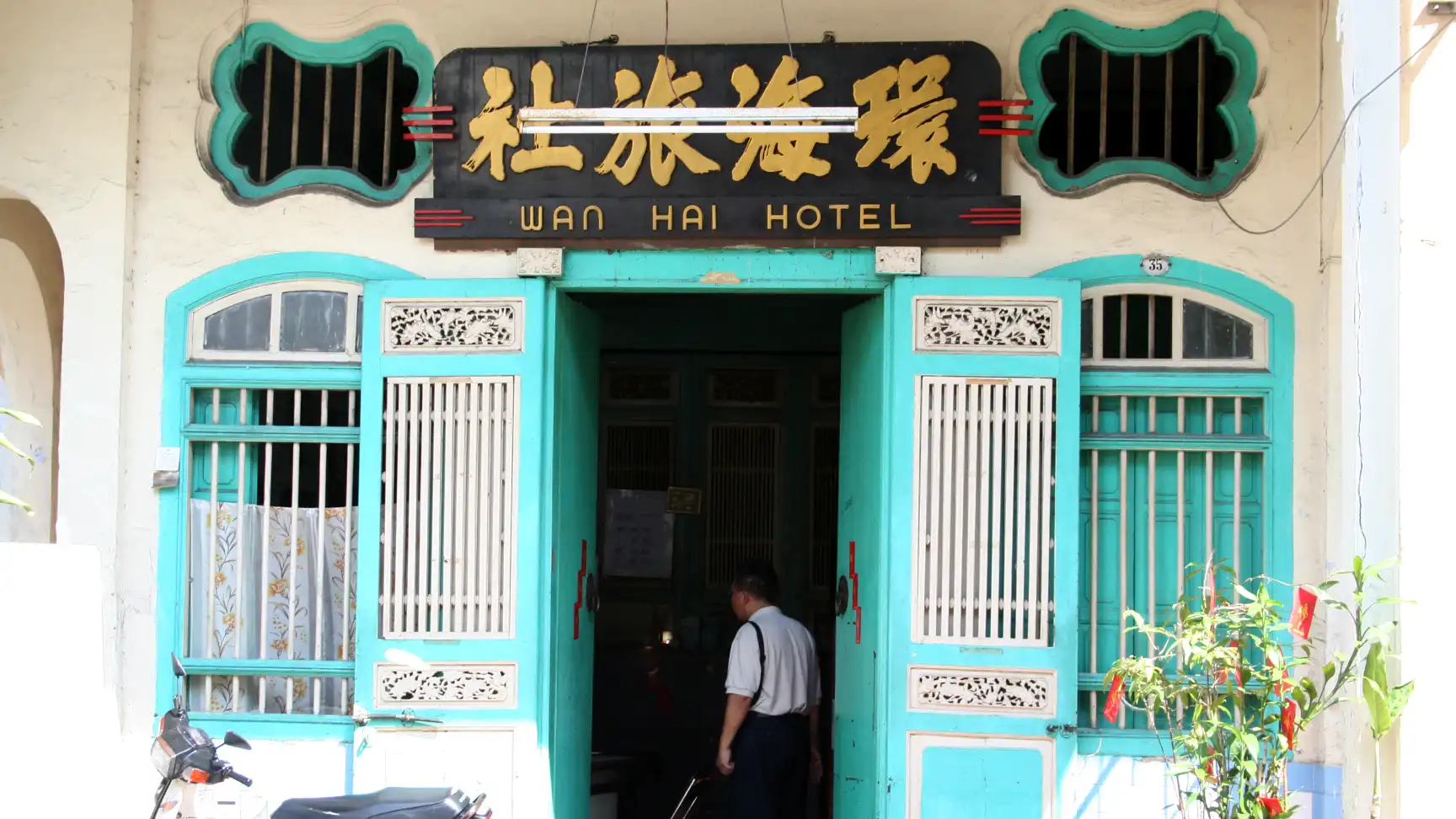
Wan Hai Hotel, Love Lane, Georgetown
Backpacker Hostels
- Ryokan Muntri Boutique Hostel: A stylish hostel located in George Town, offering dormitory-style accommodations and a cozy atmosphere for budget travelers.
- Red Inn Court: A popular hostel housed in a heritage building in George Town, offering affordable dormitory beds and a communal atmosphere.
- Tofu Cafe Beds & Bikes: A unique hostel and cafe concept, offering budget-friendly dormitory beds, bicycle rentals, and a relaxed vibe in George Town.
- Chulia Heritage Hotel: A budget-friendly hostel located in the heart of George Town's heritage district, offering dormitory beds and easy access to attractions.
- House of Journey: A cozy hostel located in a heritage building in George Town, offering affordable dormitory beds, communal spaces, and a friendly atmosphere.
- Kimberley House: A budget hostel located in George Town's bustling Kimberley Street, offering dormitory beds, a communal kitchen, and a social atmosphere.
- Old Penang Guesthouse: A well-known hostel located in a heritage building in George Town, offering budget-friendly dormitory beds and a communal courtyard.
- Ryokan @ Muntri Street Penang: A sister hostel to Ryokan Muntri, offering budget dormitory beds in a heritage building in George Town's Muntri Street.
- Chulia Mansion: A boutique hostel located in the heart of George Town, offering stylish dormitory beds, private rooms, and a rooftop terrace with city views.
- Reggae Mansion Hostel Penang: A lively hostel located in George Town, offering dormitory beds, private rooms, a rooftop bar, and a vibrant atmosphere.
Book Accomodation Through booking.com
Booking.comGetting There & Getting Away
Air
Several airlines operate flights to Penang International Airport (PEN), connecting the island to various domestic and international destinations. Here are some of the airlines that commonly fly to Penang:
- Malaysia Airlines: Malaysia's national carrier offering domestic flights from Kuala Lumpur and other cities in Malaysia to Penang. They also operate international flights to Penang from destinations such as Singapore.
- AirAsia: A low-cost carrier providing domestic and international flights to Penang from various cities in Malaysia and other countries in the region, including Thailand, Indonesia, and the Philippines.
- Malindo Air: Offering domestic flights from Kuala Lumpur and Johor Bahru to Penang. They also operate international flights to Penang from destinations such as Bangkok and Jakarta.
- Singapore Airlines: Operates international flights to Penang from its hub at Singapore Changi Airport, providing connections from major cities worldwide.
- Thai Airways: Provides international flights to Penang from Bangkok, offering convenient connections for travelers from Thailand and beyond.
- Scoot: Low-cost carrier operating flights to Penang from various cities in Asia, including Singapore and Bangkok.
- Firefly: Subsidiary of Malaysia Airlines offering domestic flights to Penang from cities such as Kuala Lumpur and Subang.
- SilkAir: Regional wing of Singapore Airlines operating flights to Penang from Singapore, providing connections from other cities in its network.
Ferry
The stately old ferries that used to ply between Butterworth and Georgetown were decommissioned in 2021 and replaced with speedier boats. We loved the old ferries, and I remember clearly first catching one in the 1980's. All things must progress unfortunately. The ferry service takes just 8–10 minutes to cross from the mainland, and runs from arounf 6AM to 8PM. Fare is just RM2 per person for foot traffic and RM2.50 for a motobike with rider and pillion passenger
Getting Around
Taxis
The local taxis can be very cheap, but unfortunately they have a reputation of cheating people, especially if you look rich and foreign. That said, we've had some amazingly good and pleasant experiences hiring them for all—day tours. It probably depends on your negotiating experience. Avoid catching them from places like the Ferry Terminal, where they're particularly notorious. Also, if you catch a cab one–way, think carefully how you will return from an isolated location
Rideshare
The local rideshare company is Grab, which is usually cheap and reliable.
Bus
The public bus network is very cheap and reasonably frequent. Full details can be found on the Rapid website.
Practical Considerations
Emergency Contacts
In case of an emergency in Malacca (or anywhere in Malaysia) you can contact the following services:
- Police - Emergency number: 999
- Fire Department - Emergency number: 999
- Tourist Police - Phone: 999
- Emergency Medical Services - Phone: 999
It's a good idea to have these numbers saved in your phone or written down in case of an emergency. Additionally, if you're traveling to Malacca as a tourist, you can also contact your embassy or consulate in Malaysia for assistance in case of an emergency.
Popular Apps in Malaysia
Some popular and usefus apps for your smartphone include:
- Grab You can essentially grab everything with the app, from rides, food, and groceries to home services, Grab is without a doubt the most well-known and comprehensive super app in Malaysia
- AirAsia The top no-frills airline in Southeast Asia is redefining itself to become ‘The Asean Super App’ AirAsia started other services during the pandemic
- Boost Retail, food and beverage, grocery, services, and other businesses are represented in the marketplace of the hybrid Boost app
Summary
Copyright © 2025 travel-with-mark.com. All rights reserved. No part of this website or any of its contents may be reproduced, copied, modified or adapted, without the prior written consent of the owner, unless otherwise indicated for stand-alone materials. Unauthorized use is strictly prohibited. All trademarks, service marks, and trade names used in this website are the property of their respective owners and are used for identification purposes only. Your access to and use of this website is subject to our terms and conditions. Details of our privacy practices may be found in our privacy notices